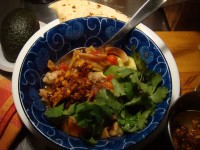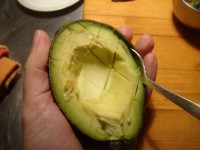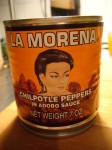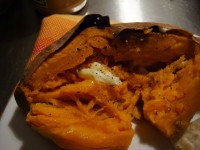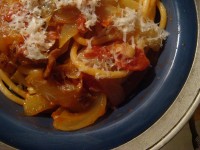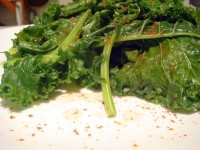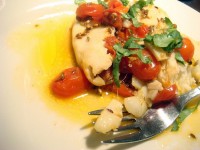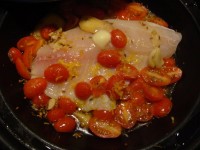Podcast: Play in new window | Download
This week, we cook a little risotto–it’s not as complicated or as fussy as you think. And it’s a very adaptable dish. On the side, we roast up some wee brussels sprouts and douse them in garlic and anchovies–what’s not to love?
Shopping list
-
1 small butternut, kabocha or acorn squash
Butternut-Squash Risotto
 Learn to make risotto, and you’ve got an immensely versatile dish under your belt–you can throw just about anything in. This combination capitalizes on fall flavors–squash and sage, with a boost of bacon (though that’s optional). The nuts on top (almonds here, but you could use hazelnuts or even pecans) add a little extra protein, as well as essential crunch–it’s the variety of textures that take this from gooey side dish to main-meal material.
Learn to make risotto, and you’ve got an immensely versatile dish under your belt–you can throw just about anything in. This combination capitalizes on fall flavors–squash and sage, with a boost of bacon (though that’s optional). The nuts on top (almonds here, but you could use hazelnuts or even pecans) add a little extra protein, as well as essential crunch–it’s the variety of textures that take this from gooey side dish to main-meal material.
Serves 2 generously
1 small winter squash or pumpkin (see note)
Olive oil
Salt
1 1/2 cups chicken or vegetable broth
1 slice thick-cut bacon
1 small onion
2 large pinches dried sage (or 10-12 leaves fresh, chopped fine)
1/2 cup short-grain rice (see note)
Parmesan
1 tablespoon butter
Large handful (1/4 cup or so) almonds
Preheat oven to 400. Slice squash into large wedges, scrape out seeds then cut off peel with a sharp knife. Cut squash into small pieces–1/2-inch square or so, though irregular sizes are fine, and even a bonus here, as the smallest ones will get quite soft and blend in with the risotto, and others will stay firmer and whole. Toss the pieces with a drizzle or two of olive oil, just to coat, and lay the pieces out on a baking sheet or (if not too crowded) a heavy skillet. Sprinkle with a bit of salt. Place in oven and roast for about 30 minutes, until the squash is soft all the way through.
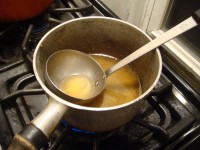
Pour broth into a small saucepan and set on a back burner on low heat to warm. Cut bacon into 1/4-inch pieces and set to fry over medium heat in a heavy-bottomed saucepan–this is the pan you’ll be making your risotto in.
Cut onion into thin slices. When the bacon is half-crispy, add the onions to the pan, along with a pinch of salt, and stir and fry. Add the sage and continue to cook, until the sage is fragrant and the onions are translucent and soft–this can take 5 minutes or so. When the onions are ready, add the rice. Stir and fry until the rice is coated with oil and somewhat translucent.
Add a couple of ladlesful of warm stock and stir thoroughly to combine. If you have nothing else to do in the kitchen, continue to stir. (If you do have other tasks, you can leave the risotto unattended until you hear the liquid cooking away.) Continue to stir and add stock, ladleful by ladleful, as the rice absorbs the liquid and a velvety sauce forms around the rice. Depending on your rice, you may or may not use all of the stock–I usually wind up just adding everything I’ve heated up, and it usually turns out fine.
When rice is al dente–it still has a bit of firmness to it–and the mixture is fairly loose (it will thicken as it sits), turn off the heat. Grate in a generous amount of Parmesan cheese, and stir in the butter. Put the lid on the pan and let the risotto sit for about 5 minutes.
During this time, roughly chop your almonds and toast them in a dry skillet over high heat, just until lightly browned. Remove them from the hot skillet as soon as they’re browned to your liking.
Stir the roasted squash into the thickened risotto, squishing up some of the smaller pieces. (How much squash you add depends on your taste–you might have some squash left over.) Place in serving bowls and sprinkle over the toasted almonds, along with a bit more grated Parmesan.
Notes:
Squash: You can use butternut, kabocha or acorn squash–anything that’s firm, orange and a bit sweet. In the podcast, I use a wedge of calabaza–a kind of pumpkin that’s used in Latin America and the Caribbean. Butternut squash is by far the most common, but it’s hard to find small enough squash so that you won’t be overwhelmed with it when cooking for just a couple of people–but leftover roast squash is not a bad thing to have around. (And please avoid that precut squash! Who knows how many days/weeks it’s been sitting around! Really, it takes very little time to peel and prep a squash.)
Rice: Classic risotto recipes call for arborio rice, an Italian grain that’s hard to find and expensive when you do. I have found that Japanese sushi rice works quite well too–it happens to be much easier for me to buy, and it’s significantly cheaper. But any short-grain rice will work reasonably well.
Roasted Brussels Sprouts with Anchovies and Garlic
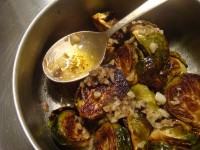 As I say in the podcast, when in doubt with vegetables, roast them. Brussels sprouts roast up particularly well, getting a nice crunchy outside and sweetening a bit in the process. Even if you think you don’t like brussels sprouts, try them once this way–I think you’ll change your mind. Dousing them in anchovies and garlic (skip the anchovies if you’re veg, obviously–it will still be tasty) makes them incredibly savory, and a nice counterpoint to the sweetness of the squash in the risotto.
As I say in the podcast, when in doubt with vegetables, roast them. Brussels sprouts roast up particularly well, getting a nice crunchy outside and sweetening a bit in the process. Even if you think you don’t like brussels sprouts, try them once this way–I think you’ll change your mind. Dousing them in anchovies and garlic (skip the anchovies if you’re veg, obviously–it will still be tasty) makes them incredibly savory, and a nice counterpoint to the sweetness of the squash in the risotto.
Serves 2
1 pint brussels sprouts
Olive oil
Salt
2 or 3 cloves garlic
2 or 3 anchovy filets
Preheat oven to 400. Trim bottom ends of brussels sprouts and slice in half lengthwise. Drizzle a bit of olive oil on a baking sheet, then lay out the sprouts, cut side down, rubbing each one in oil. Drizzle a bit of oil over the tops of the sprouts as well, and sprinkle with salt. Roast until the cut sides are nicely browned, about 30 minutes.
Set a small saucepan over medium heat. Pour in a glug of olive oil. While it’s warming, chop your garlic cloves fine or squeeze them through a press. When the oil is hot, add the anchovy filets, mashing them with the side of your spoon, so they melt into small pieces. Add the garlic and stir and fry until fragrant.
Put the roasted sprouts in a serving bowl, then pour the hot anchovy-garlic mixture over them and toss lightly.

